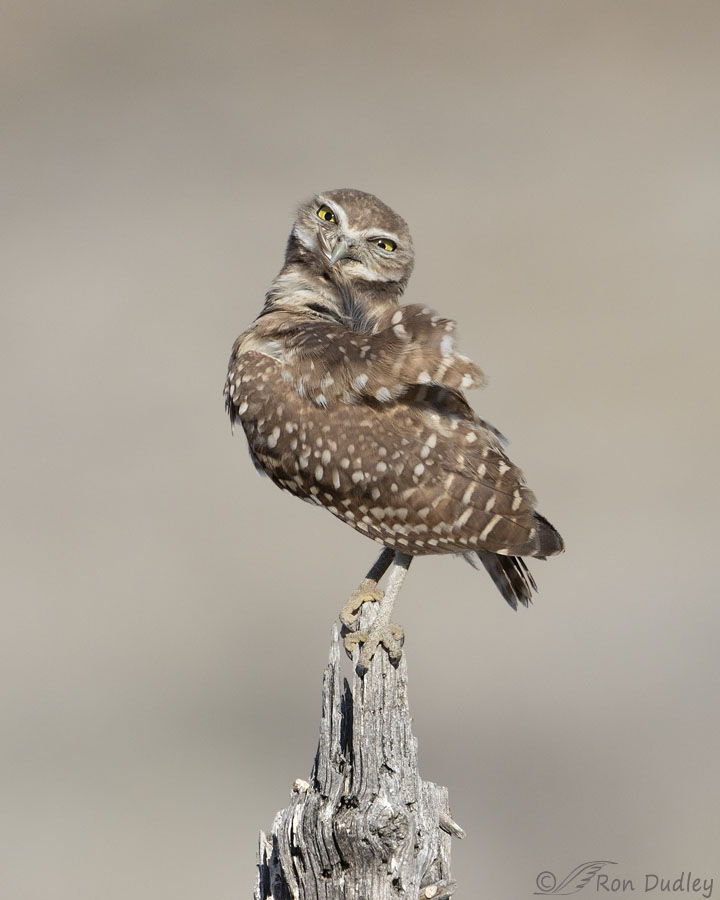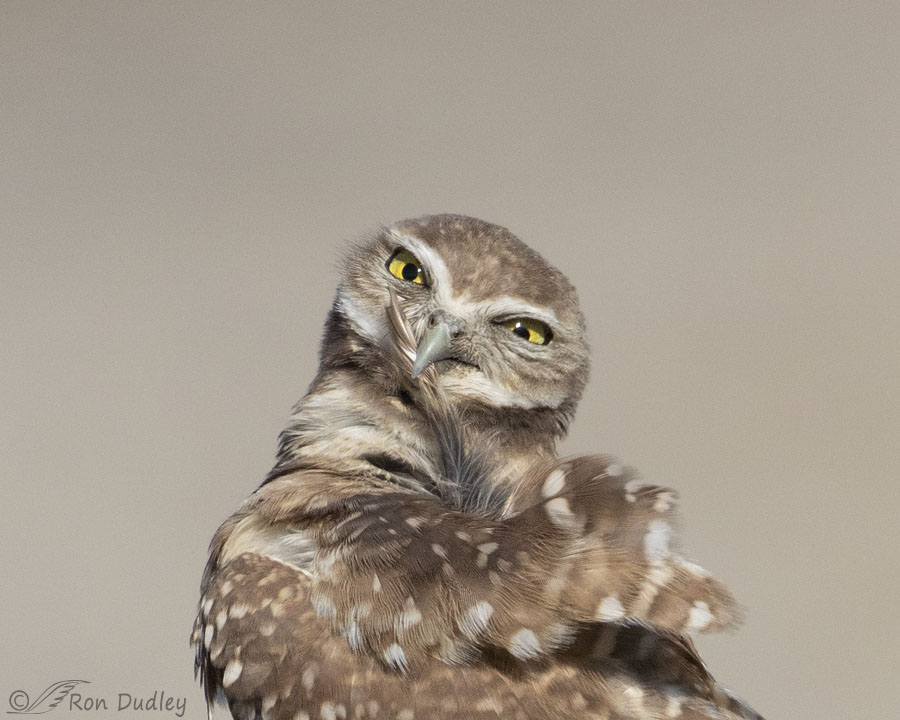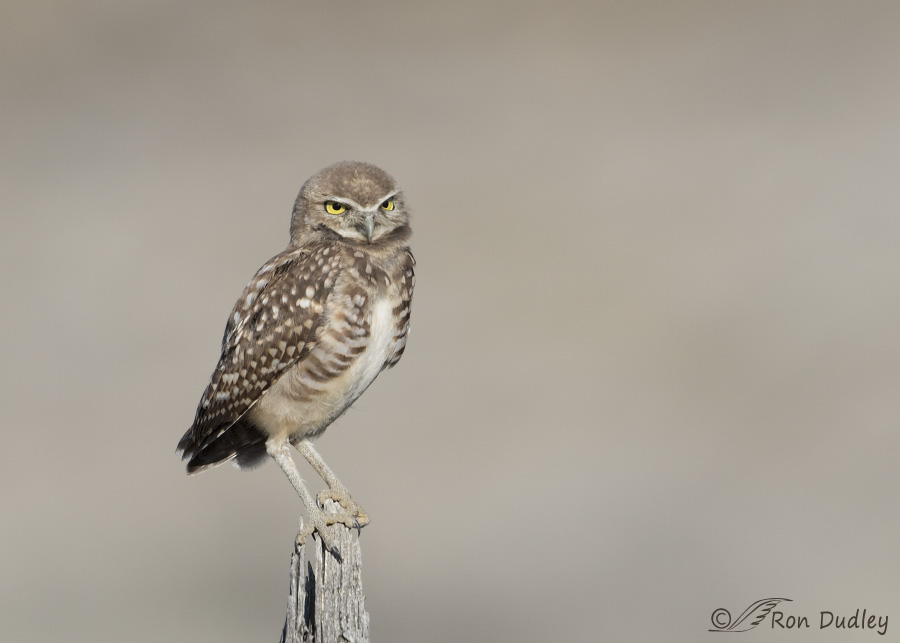A mystery to me anyway but then maybe I’m missing something obvious.

1/3200, f/7.1, ISO 500, Canon 7D Mark II, Canon EF 500mm f/4L IS II USM + EF 1.4 III Extender, not baited, set up or called in
Last night while looking for something else I stumbled across this older photo of a preening juvenile Burrowing Owl. Something about ‘his’ eyes just didn’t look quite right so I zoomed in on the high resolution version of the image for a closer look.

That’s when I noticed that his right eye is looking forward but his left eye appears to be looking at, or attempting to look at, the feather in his bill. But owls are known to be unable to move their eyes within their skulls so how could that be? The National Geographic Resource Library explains it this way:
“Owls can’t move their eyeballs. That’s because owls don’t have eyeballs at all. Instead, their eyes are shaped like tubes, held rigidly in place by bones called sclerotic rings. (Human eye sockets, which hold spherical eyes, do not have sclerotic rings.)
Because owls can’t roll their eyes around the way we do, they have to move their entire head to get a good look around. They frequently twist their head and “bob and weave” to expand their field of view. Owls can turn their necks about 270° in either direction, and 90° up-and-down, without moving their shoulders!”
So I’m curious about what’s going on here. Could it be that I’m misinterpreting what I’m seeing and the owl isn’t really looking in different directions with his eyes? I don’t think so but if not what’s the explanation?

In other photos I have of this bird his eyes appear ‘normal’ so I’m confused.
What say ye, friends? Any thoughts? And if it’s just me missing something obvious, have no mercy.
Ron
PS – How could anyone in their right mind think daylight saving time is a good idea? Rhetorical question…


One writer advocates retiring DST altogether, and reducing the total number of time zones in the contiguous states to 2. No longer would there be any time changes.
I agree with Marty and Porcupine. The owl’s eyes seeming to be different are an optical illusion (pun intended). The little burrowing owl looks deep in the moment as she preens. It reminds me of my cats when they are grooming. They zone out and their eyes are not focusing. I have watched enough birds to know they do the same. Preening is self-comfort for birds.
Thanks for your input, Melanie.
Mystery solved…or not, any imge of a Burrowing Owl makes me smile
I know what you mean, Patty.
If i remember correctly, Owl irises have striated muscle which enable them to independently control pupil size in each eye. That may contribute to what you are seeing. Or perhaps this owl has a bit of strabismus a la Forrest Whitaker.
There was a good article in the Seattle Times yesterday. The takeaway I got was the bill stalled in congress to move to DST permanently is backward. We should go to standard time.
Lyle, whichever way they go – if they ever do – I wish they’d just get off the pot and DO IT. I could live with either one if I had to – it’s the change I don’t like.
Washington State voted to stay on Daylight Savings Time year-round several years ago. While states can opt out of daylight saving time – as Hawaii and most of Arizona have done – federal law requires an act of Congress to allow states to adopt daylight saving time on a permanent basis. Congress has yet to act to approve it. I believe California and Oregon have passed similar laws, which would make all the west coast states using the same time clock if Congress ever gets off it’s butt and actually allows the implementation of laws that “the people” have already voted for and approved. You’d think they could at least get that right.
Thanks for clearing that up, Karen.
I agree with the others about the illusion. The difference in pupil size is part of the problem. Most birds can control the pupil size of each eye independently and that appears to be the case here. Since owls eyes face forward, this effect is much more noticeable than in other birds whose eyes are directed more to the side. Your quote source, I think, lacks a bit in clarity and can give a wrong impression. Only the front portion of an owl’s eyes are tubular and protrudes forward. The rear portion of the eye is hemispherical. And it’s not just owls that have a sclerotic ring; all birds have this ring of bony plates. However, they are much more prominent in owls. In most birds these are relatively flat plates that form a ring in front of the eye. In owls, they are much larger and each plate curves forward from the front of the hemispherical portion of the eye to alongside the base of the tubular portion of the eye, locking the eye more firmly in one position. An interesting photo whatever explanation you care to give.
Thanks, Dan. I was hoping you’d weigh in.
And based on what you said, I agree – the NG quote is misleading.
Reading through the comments I agree with Marty K, Porcupine et al that the eye ‘seems’ to be a little more closed.
A fascinating question to charge my early morning brain though.
We moved to daylight saving a few weeks ago. It is still dark here, and will be for some hours yet.
Interesting to know you have DST time too, EC.
I was curious about how many countries do and don’t have DST so I looked it up. “About 70 countries — less than 40% — observe Daylight Saving Time. Most of North America, Europe and parts of South America and New Zealand adhere to it, while China, Japan, India and most countries do not. It starts on different dates elsewhere. In Australia for example, Daylight Saving Time started Oct. 3.”
Not all of our country is forced to endure it – which makes for some challenging times for people who live in and work in different states.
Same here, EC. Arizona and Hawaii don’t have DST. All the rest of our states do.
Cannot see any other way to go than to agree with Porcupine who definitely would have to be the most expert among us
Neat photos though and your curiosity is to be commended.
Thank you, Everett.
I have read several studies that indicated birds can move their eyeballs a fraction. However, the unusual shape of the owl’s eye seems to contradict that, as Porcupine, who clearly has seen many owl eyes, says. So the studies may not include owls. They did include hawks and falcons. I’ll look for the references and send them along if I find them.
Sallie, as far as I knew it’s only owls that aren’t supposed to be able to move their eyes at all.
Having done a few surgeries on owl eyes, I can assure you that they cannot move their eyes within their skulls. It is an anatomic impossibility. The only explanation I can offer is that because the lids are open different amounts and the pupils are dilated differently, it creates the illusion of looking different directions. Very interesting photo.
Then I guess that must be it, Porcupine. I can think of no other explanation that makes any sense.
I agree – illusion due to eyelids being open different amounts?
I’m going to have to agree with Marty K. If you look at all the other facial features, everything is symmetrical. The lower eyelid is raised up, while the eyeball appears to be on the same plane as the opposite eye.
Bernie, there has to be a logical explanation and maybe what you and Marty suggest is it. But when I look at the relative position of those eyes I’m just not seeing it. Perhaps just an issue with me and my perception…
Tilt your head. Then pull that lower eyelid down in you mind.
You’ll see it.
The experts say that owls only blink by moving their upper eyelid down. The only time they raise their lower eyelid is when they’re sleeping.
When I look at that photo I just can’t see both eyes looking in the same direction. Maybe it’s like an illusion that only some people can see and it’s just me being a little dense.
Interesting! Left eye seems closed a bit more than the right to me perhaps giving that impression?
Have all sorts of nasty words for your “rhetorical question”….. 🙁 Takes me forever to adjust….
Judy, I’ve been up for so damn long it seems like the day should be at least half over by now. And it’s still dark outside!
I wonder if the left eye being a bit more closed has something to do with the illusion. To me, the eyelid position makes it seem like there’s less iris medially; hence, the slightly “cross-eyed” appearance.
“I wonder if the left eye being a bit more closed has something to do with the illusion”.
Possibly, if it is an illusion. Thanks for your thoughts, Marty.